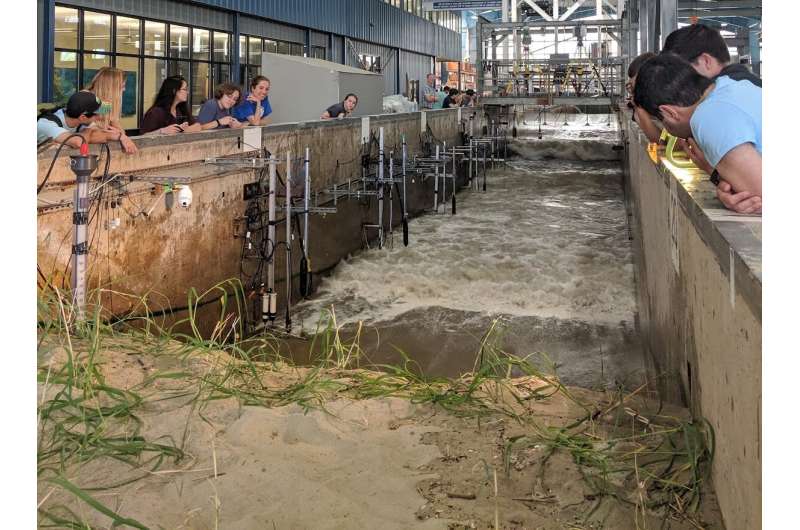This article has been reviewed according to Science X's editorial process and policies. Editors have highlighted the following attributes while ensuring the content's credibility:
fact-checked
peer-reviewed publication
trusted source
proofread
Newly planted vegetation accelerates dune erosion during extreme storms, research shows

Newly planted vegetation on coastal sand dunes can accelerate erosion from extreme waves, a study involving researchers from the Oregon State University College of Engineering suggests.
The authors note the findings run counter to the widely accepted paradigm that vegetation always acts to reduce erosion on dunes, the first line of storm defense for landscapes that are among the world's most ecologically important and economically valuable.
The experiments involved building beach dune profiles 70 meters long and 4.5 meters high and subjecting them to storm waves in a 104-meter-long flume at OSU's O.H. Hinsdale Wave Research Laboratory.
Researchers spent six months growing coastal switchgrass, a common dune plant known scientifically as Panicum amarum, within the flume before beginning wave testing.
"This project required the participation of five principal investigators from different universities nationwide, about 10 coastal scientists and 15 grad students working together in our large wave flume for almost nine months," said Pedro Lomonaco, director of the wave research lab. "Various instruments measured the wave conditions, sediment transport, underground water level changes, beach profile evolution and relevant metrics. The experiments we conducted represent a landmark for testing at a large scale."
Findings of the study were published June 14 in Science Advances.
The research is crucial, notes Oregon State's Meagan Wengrove, because the United States coastline is dotted with communities trying to protect themselves from storms by planting vegetation on dunes in an attempt to make the dunes higher and more stable.
The authors say the existing body of dune research shows that vegetation size, density and diversity are associated with less erosion, but those studies have been limited to relatively small wave events over time scales measured in minutes.
"In our research we found that a newly planted coastal dune that does not have a very established root structure scarped faster than a bare dune with the same sand size and compaction," said Wengrove, assistant professor of civil and construction engineering.
Scarping is when a sand dune, or other hillside, erodes into a steep shape that's vertical or close to it. A scarped dune is inherently unstable, putting structures and roadways near it at risk and threatening the surrounding ecosystems.
"We still need to learn more about how different levels of vegetation establishment influence coastal dune vulnerability to wave-driven erosion, but this work is an important step toward understanding the role vegetation plays," she said.
The collaboration led by Rusty Feagin of Texas A&M University found that while vegetation initially created a physical barrier to wave energy during a severe storm situation, it also increased water penetration into the sediment bed, which induced destabilization and sped up scarp formation. "Once a scarp forms, the erosion accelerates even more," Wengrove said.
More information: Rusty Feagin, Does vegetation accelerate coastal dune erosion during extreme events?, Science Advances (2023). DOI: 10.1126/sciadv.adg7135. www.science.org/doi/10.1126/sciadv.adg7135
Journal information: Science Advances
Provided by Oregon State University



















